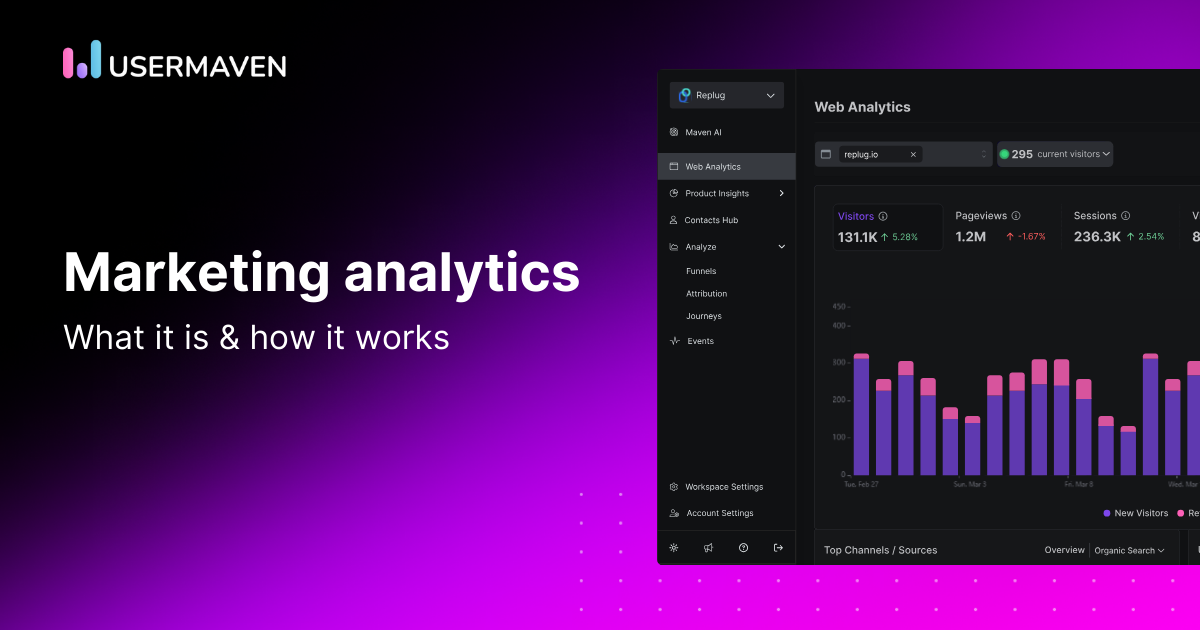Stop wasting time and money on marketing!
Your marketing team could save hundreds of hours with advanced tracking features and precise data (yes, you read that right!).
That’s the level of efficiency you can achieve with powerful marketing analytics.
In today’s data-driven world, businesses are flooded with information. But without the tools to analyze and understand it, that data is just noise. That’s where marketing analytics becomes your secret weapon.
The real value of marketing analytics lies not just in gathering numbers but in transforming them into actionable insights that drive smarter, more effective marketing decisions.
Let’s dive in;
Understanding marketing analytics
Marketing analytics involves the collection, analysis, and interpretation of marketing data to gain insights into various aspects of marketing. This data can come from various sources, such as website analytics, social media metrics, email marketing campaigns, and customer databases.
One of the key goals of marketing analytics is to evaluate the effectiveness of marketing efforts. Through data analysis, businesses can measure the success of their marketing campaigns, identify areas for improvement, and make data-driven decisions to optimize their marketing strategies.
Digital marketing has revolutionized the way businesses reach their target audience, and marketing analytics plays a crucial role in maximizing the effectiveness of digital marketing efforts. By analyzing various digital marketing metrics, such as website traffic, click-through rates, and conversion rates, businesses can gain insights into customer behavior, preferences, and interests. This information can then be used to tailor marketing campaigns to the specific needs and preferences of the target audience.
Marketing analytics involves the use of various tools and techniques to analyze and interpret marketing data. These tools can range from simple web analytics platforms, such as, to more advanced marketing analytics software that provides in-depth data analysis and insights. The choice of tools depends on the specific needs and goals of the business.
The role of marketing analytics in business growth
Marketing analytics plays a crucial role in driving business growth. By analyzing marketing data, businesses can gain insights into customer behavior, preferences, and interests. This information can inform marketing strategies, allowing businesses to target their marketing efforts more effectively and drive customer engagement.
Marketing analytics provides businesses with the data they need to evaluate the success of their marketing activities. By measuring key performance indicators, such as
- conversion rates
- customer lifetime value
- customer acquisition costs
Businesses can assess the effectiveness of their marketing campaigns and make data-driven decisions to optimize their marketing efforts.
Furthermore, marketing analytics helps businesses identify trends and patterns in customer behavior. By understanding these trends, businesses can stay ahead of the competition and identify new opportunities for growth.
Key benefits of investing in marketing analytics
Investing in marketing analytics offers several key benefits for businesses.
- Firstly, it enables businesses to make strategic decisions based on data-driven insights. By analyzing marketing data, businesses can understand what is working and what isn’t, allowing them to allocate resources more effectively and optimize their marketing strategies.
- Secondly, marketing analytics allows businesses to measure and evaluate their marketing performance. By tracking key performance indicators, such as conversion rates, customer acquisition costs, and return on investment, businesses can assess the effectiveness of their marketing campaigns and make data-driven decisions to improve performance.
- Furthermore, marketing analytics can help businesses increase brand awareness and customer engagement. By analyzing customer data, businesses can gain insights into customer preferences, behaviors, and interests, allowing them to create personalized marketing campaigns that resonate with their target audience.
How to get started with marketing analytics?
To set up for success in marketing analytics, you will need a few key elements.
Let’s look into the steps you should follow for a successful marketing analytics strategy;
Step 1: Define your marketing goals and objectives
The first step in getting started with marketing analytics is to define your marketing goals and objectives. Clearly identify what you want to achieve with your marketing efforts. This could be increasing brand awareness, driving sales, improving customer engagement, or any other marketing objective that aligns with your business goals.
Once you have defined your marketing goals, it’s important to break them down into specific, measurable targets. For example, if your goal is to increase brand awareness, you might set a target of reaching a certain number of social media followers or website visitors.
Pro tip: You can create conversion goals with Usermaven and analyze your goal activity daily.
Next, consider your target audience. Who are you trying to reach with your marketing efforts? Understanding your target audience is crucial for effective marketing analytics. Identify the demographics, interests, and behaviors of your target audience. This will help you collect and analyze data that is relevant to your marketing efforts and target audience preferences.
By defining your marketing goals and objectives and understanding your target audience, you will have a clear direction for your marketing analytics efforts and be able to collect and analyze data that is relevant and actionable.
Step 2: Collect and segment your data
The next step in getting started with marketing analytics is to collect and segment your data. Start by identifying the relevant data sets for your marketing efforts. This may include website analytics data, social media metrics, email marketing data, customer databases, and any other data sources that are relevant to your marketing goals.
Once you have collected your data, it’s important to segment it based on relevant factors. This could include segmenting your data by demographics, customer behavior, purchase history, or any other relevant data points. By segmenting your data, you can gain deeper insights into different customer segments and tailor your marketing efforts accordingly.
Pro tip: Usermaven offers segmentation of users based on their touchpoints, devices, location, and the pages they land on.
Segmentation is crucial for effective marketing analytics as it allows you to analyze the data in a more targeted and meaningful way. It helps you understand the customer journey, identify trends, and uncover valuable insights that can drive your marketing strategy.
Step 3: Choose the right marketing analytics tools
Choosing the right marketing analytics tools is a crucial step in getting started with marketing analytics. There are various tools available that can help you collect, analyze, and interpret your marketing data.
Consider your specific needs and goals when choosing your analytics tools. Do you need a simple web analytics platform, or do you require more advanced marketing analytics software? Some popular options include Usermaven (for website and product analytics) and ContentStudio (For social media analytics and management).
When choosing your tools, consider factors such as ease of use, data visualization capabilities, integration with other marketing platforms, and cost. It’s important to choose tools that align with your marketing analytics strategy and provide you with the insights and data analysis capabilities you need to make informed decisions.
The right marketing analytics tools can provide you with valuable insights into your marketing performance, customer behavior, and overall marketing effectiveness. They can help you measure the success of your marketing campaigns, identify trends, and optimize your marketing efforts to achieve better results.
Step 4: Analyze data to uncover insights
Once you have collected and segmented your data, it’s time to analyze it to uncover valuable insights. Data analysis is a crucial step in the marketing analytics process as it allows you to make informed decisions and optimize your marketing efforts.
Start by analyzing your data to identify trends, patterns, and correlations. Look for insights that can help you understand customer behavior, preferences, and interests. This could include analyzing website traffic, click-through rates, conversion rates, and other key performance indicators.
As you analyze your data, look for actionable insights that can drive your marketing decisions. What can you learn from the data that can help you optimize your marketing campaigns, improve customer engagement, and achieve your marketing goals? Use the data to inform your marketing strategy and make data-driven decisions that can lead to better results.
Step 5: Implement findings and monitor results
The final step in getting started with marketing analytics is to implement your findings and monitor the results. Use the insights and actionable insights from your data analysis to make informed decisions and optimize your marketing efforts.
Implement the findings from your data analysis into your marketing campaigns. Make changes to your messaging, targeting, or channels based on the insights you have gained. Continuously monitor the performance of your marketing efforts and make adjustments as needed to achieve your marketing goals.
In addition to implementing your findings, it’s important to measure and track the results of your marketing campaigns. Use marketing measurement tools and techniques to evaluate the effectiveness of your campaigns and make data-driven decisions for future campaigns. Track key performance indicators, such as conversion rates, customer acquisition costs, and return on investment, to assess the success of your marketing efforts.
By implementing your findings and monitoring the results, you can continuously improve your marketing performance, optimize future campaigns, and achieve better results.
Pro tip: For analyzing your performance, Usermaven provides Reports that provide a comprehensive analysis of visitors to goals and everything.
How Usermaven help in marketing analytics?
Usermaven empowers your marketing team with advanced tools to turn data into decisions:
- Goals tracking: Set and monitor goals effortlessly, ensuring your marketing efforts align with business objectives.
- Segmentation: Dive deep into customer segments to tailor your marketing strategies and improve targeting.
- AI insights: Our AI-driven funnel insights in funnels, attribution, and journey reveal hidden patterns and opportunities, optimizing every stage of your customer journey.
- Journey and Attribution analysis: Understand every touchpoint in the customer journey, and attribute success accurately across channels with our comprehensive journey and attribution analysis.
- Maven AI: Get intelligent, data-backed recommendations to enhance your marketing strategies, making data-driven decisions easier than ever.
- Comprehensive reports: Access detailed reports that provide a clear picture of your marketing performance, helping you make informed decisions.
With Usermaven, you can transform your marketing analytics into a powerful tool for growth.

Advanced tips for maximizing your marketing analytics efforts
Marketing analytics goes beyond basic data analysis and offers advanced techniques to maximize its effectiveness. Here are some advanced tips to maximize your marketing analytics efforts:
- Utilize predictive analytics:
Predictive analytics uses historical data and machine learning algorithms to predict future outcomes. By analyzing patterns and trends in the data, businesses can make accurate predictions about customer behavior and preferences. This helps create targeted marketing campaigns and optimize marketing strategies.
- Implement machine learning algorithms:
Machine learning algorithms can analyze large amounts of data and identify patterns and trends that humans might miss. By utilizing machine learning algorithms, businesses can gain deeper insights into customer behavior and preferences. This can help personalize marketing messages and improve customer engagement.
- Leverage advanced analytics tools:
Several advanced analytics tools, like Usermaven, are available on the market that can help businesses analyze their marketing data more effectively. These tools offer features like data visualization, predictive modeling, and real-time analytics. By using these tools, businesses can gain deeper insights into their marketing campaigns and make data-driven decisions.
- Conduct A/B testing:
A/B testing is a technique used to compare two versions of a marketing campaign to determine which one performs better. By testing different variables, such as headlines, images, or call-to-action buttons, businesses can identify the most effective elements of their marketing campaigns. This helps optimize marketing efforts and improve campaign performance.
- Incorporate data from different sources:
To get a complete picture of the marketing performance, it is important to collect data from different sources. This includes web analytics, social media analytics, email marketing analytics, and more. By analyzing data from various sources, businesses can gain a holistic view of their marketing efforts and make informed decisions.
- Continuously measure and analyze results:
Marketing analytics is an ongoing process. It is important to continuously measure and analyze the results of marketing campaigns. By monitoring key metrics and analyzing the data, businesses can identify areas for improvement and optimize their marketing strategies. This helps achieve better results and maximize the return on investment (ROI).
By implementing these advanced tips for marketing analytics, businesses can gain deeper insights into their target audience, optimize their marketing strategies, and achieve better results from their marketing campaigns.
Conclusion
In conclusion, harnessing the power of marketing analytics can lead to significant time savings and enhanced business growth. By investing in analytics tools like Usermaven and understanding your marketing goals, you can unlock valuable insights that drive informed decision-making and optimize your strategies.
Whether you’re a beginner or looking to advance your analytics efforts, following a structured approach and leveraging advanced techniques like AI can propel your marketing success.
Embrace analytics to track performance, identify trends, and stay ahead in today’s competitive landscape. Start your analytics journey now to save time, boost efficiency, and achieve remarkable results.

FAQs
What is the best marketing analytics tool for beginners?
The best marketing analytics tool for beginners depends on specific business needs. Some popular user-friendly and affordable options include Usermaven, ContentStudio, and Adobe Analytics.
How often should I review my marketing analytics data?
The frequency of reviewing marketing analytics data depends on various factors, such as campaign duration and marketing goals. It is recommended to review data regularly, at least on a weekly or monthly basis, to track marketing performance and make timely adjustments.
Can marketing analytics improve customer experience?
Yes, marketing analytics can improve customer experience. By analyzing customer data and behavior, businesses can gain insights into customer preferences and tailor their marketing efforts to create personalized and relevant experiences throughout the customer journey.
What are the key metrics to focus on in marketing analytics?
The key metrics to focus on in marketing analytics depend on the specific marketing goals and objectives. Some common key metrics include conversion rate, bounce rate, open rate, click-through rate, customer acquisition cost, and return on investment (ROI).

Leave a Reply